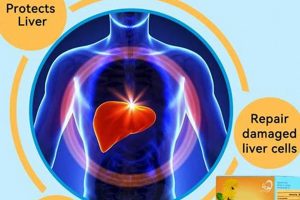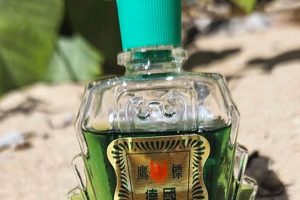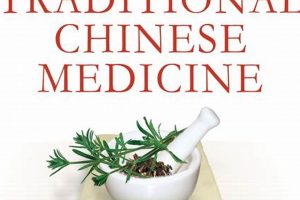These medicated adhesives, commonly used in traditional medicine, deliver therapeutic ingredients through the skin. Containing a blend of plant-derived substances, they are applied topically to specific areas of the body. For example, one might be placed on the lower back to alleviate discomfort.
The appeal of this method lies in its localized application and sustained release of active compounds. Historically, this approach has been favored for its convenience and non-invasive nature. The targeted delivery bypasses the digestive system, potentially improving bioavailability of the active components and reducing systemic side effects.
The following sections will explore the composition, mechanisms of action, applications, and potential limitations associated with this form of therapeutic intervention. Furthermore, variations in formulation and preparation techniques will be discussed, along with considerations for safe and effective utilization.
Application Strategies for Topical Herbal Remedies
The effective use of transdermal herbal applications requires careful consideration of several factors. The following tips outline best practices for optimal results and user safety.
Tip 1: Skin Preparation: Ensure the application area is clean and dry. Avoid lotions, oils, or other topical products that may impede adhesion or interfere with absorption. Gentle cleansing with mild soap and water is recommended.
Tip 2: Placement Accuracy: Identify the specific area of discomfort or the acupoint to be targeted. Precise placement maximizes the therapeutic effect. Consult with a qualified practitioner for guidance on appropriate acupoint locations.
Tip 3: Adhesion Enhancement: Firmly press the adhesive to the skin to ensure complete contact. Avoid wrinkles or air pockets, which can reduce adhesion and compromise drug delivery. Consider using medical tape to secure edges if necessary.
Tip 4: Monitoring for Irritation: Observe the application site for any signs of redness, itching, or irritation. Discontinue use immediately if adverse reactions occur and consult with a healthcare professional.
Tip 5: Duration of Application: Follow the recommended application time specified by the product instructions or a healthcare provider. Prolonged use beyond the recommended duration may increase the risk of skin irritation.
Tip 6: Storage and Handling: Store unused applications in a cool, dry place away from direct sunlight. Ensure the packaging is sealed to maintain potency and prevent contamination.
Tip 7: Patient Education: Fully understand the intended use, potential benefits, and possible side effects before applying. Individuals with known allergies or skin sensitivities should exercise caution.
By adhering to these guidelines, individuals can maximize the therapeutic potential of this therapeutic intervention while minimizing potential risks. Careful application and diligent monitoring are essential for achieving optimal outcomes.
The subsequent sections will delve deeper into the specific formulations and research supporting the efficacy of these preparations for various health conditions.
1. Herbal Composition
The effectiveness of topical herbal applications is fundamentally linked to the specific herbal composition. The selection and concentration of herbs determine the therapeutic effects, acting as the causative agent in the alleviation of symptoms or the promotion of healing. As a primary component, the herbal composition dictates the pharmacological activity of the final product, ensuring its intended benefits are realized. For example, a patch designed for pain relief might incorporate ingredients known for their analgesic properties, such as menthol or capsaicin, directly influencing the patch’s efficacy in reducing discomfort.
Furthermore, the preparation method significantly impacts the extraction and bioavailability of active compounds from the selected herbs. Traditional methods, such as decoction or maceration, are often employed to maximize the therapeutic potential of the raw materials. The specific extraction technique can affect the chemical profile of the resulting extract, which in turn influences the efficacy and safety of the finished product. The careful combination of different herbs can also produce synergistic effects, where the combined action of multiple ingredients is greater than the sum of their individual effects. Consider a formula including both warming and blood-circulating herbs to alleviate stagnation, combining their independent properties for a stronger overall outcome.
In summary, a thorough understanding of herbal composition is crucial for appreciating the therapeutic capabilities of this topical therapeutic intervention. The precise selection, processing, and combination of herbs dictate the patch’s ability to address specific health concerns. While the transdermal delivery system facilitates absorption, it is the carefully chosen and prepared herbal composition that ultimately provides the active therapeutic benefit, ensuring the desired outcomes. Challenges remain in standardizing formulations and validating efficacy through rigorous clinical trials.
2. Transdermal Delivery
Transdermal delivery is the method by which active medicinal ingredients are transported across the skin barrier into the systemic circulation. In the context of medicated adhesives containing plant-derived substances, this delivery system is paramount to its therapeutic function. The skin, acting as a natural protective barrier, presents a significant challenge to the absorption of most substances. This topical drug delivery system, therefore, relies on specific formulation techniques and the physicochemical properties of the herbal extracts to facilitate permeation. For example, penetration enhancers, such as certain lipids or solvents, may be incorporated to temporarily disrupt the skin’s barrier function, increasing the absorption rate of the herbal constituents.
The effectiveness of transdermal delivery impacts the overall therapeutic outcome of said medicated adhesives. Unlike oral medications, this method bypasses the gastrointestinal tract and first-pass metabolism in the liver, potentially reducing the risk of systemic side effects and improving the bioavailability of certain compounds. Furthermore, it allows for sustained release of the active ingredients over an extended period, providing a consistent therapeutic effect. An example would be a patch designed for chronic pain management, where sustained transdermal delivery provides continuous analgesia, reducing the need for frequent oral medication. Proper adhesive properties and patch design are also crucial for ensuring consistent contact with the skin and preventing premature detachment, which can compromise drug delivery.
In conclusion, transdermal delivery is an integral aspect of medicated adhesives containing plant-derived substances, directly influencing their efficacy and therapeutic benefits. Optimizing this delivery system requires careful consideration of formulation, patch design, and the physicochemical properties of the herbal extracts. While this route offers numerous advantages, challenges remain in standardizing formulations, enhancing permeation for poorly absorbed compounds, and addressing individual variations in skin physiology. Continuous research and development are essential to further improve the efficacy and safety of transdermal herbal applications.
3. Localized Action
The therapeutic efficacy of topical herbal applications hinges significantly on their localized action. Unlike oral medications that distribute systemically, these applications deliver active compounds directly to the site of application. This targeted approach minimizes systemic exposure and potential side effects, while maximizing the concentration of medicinal substances at the affected area. The concept of localized action is especially pertinent in managing musculoskeletal pain, where a patch can be applied directly over the painful area to reduce inflammation and provide analgesia. This specificity ensures that the therapeutic intervention primarily affects the targeted tissues, thus reducing the likelihood of adverse reactions in other parts of the body.
The localized action allows practitioners to address conditions such as muscle strain, joint stiffness, and localized inflammation with greater precision. For example, in cases of lower back pain, a medicated adhesive placed directly on the lumbar region facilitates the delivery of anti-inflammatory and analgesic herbs precisely where they are needed. Furthermore, this targeted approach can be particularly beneficial for individuals who are sensitive to oral medications or who have contraindications to systemic treatments. The advantage of focused drug delivery also translates into potentially lower overall dosages compared to oral administration, further minimizing the risk of systemic side effects. This is exemplified in dermatology, where localized treatment of skin conditions such as eczema or psoriasis can reduce the need for systemic corticosteroids.
In summary, the localized action of topical herbal applications is a key determinant of their clinical utility. By delivering therapeutic compounds directly to the affected area, these interventions offer a targeted and potentially safer alternative to systemic medications. This localized approach optimizes therapeutic efficacy, minimizes systemic exposure, and allows for tailored treatment strategies to address specific health concerns. A deeper understanding of this connection is essential for healthcare providers and individuals seeking to leverage the therapeutic potential of medicated adhesives containing plant-derived substances. Further research is warranted to optimize formulations and delivery methods to enhance the localized action and improve clinical outcomes.
4. Pain Management
The application of medicated adhesives containing plant-derived substances in the context of pain management represents a significant intersection of traditional medicine and modern therapeutic approaches. These preparations offer a non-invasive method for delivering analgesic and anti-inflammatory compounds directly to the affected area, addressing both acute and chronic pain conditions.
- Localized Analgesia and Inflammation Reduction
Medicated adhesives provide targeted delivery of herbal constituents with analgesic and anti-inflammatory properties. This localized approach minimizes systemic exposure and side effects, while maximizing the concentration of active compounds at the site of pain. For instance, formulations containing menthol or camphor induce a cooling sensation and vasodilation, respectively, alleviating muscle soreness. Application directly over a strained muscle or arthritic joint delivers concentrated relief without the gastrointestinal burden associated with oral analgesics.
- Sustained Release and Prolonged Relief
A key advantage lies in the sustained release of herbal compounds over an extended period. The transdermal delivery system allows for a steady stream of therapeutic agents, providing prolonged pain relief compared to topical creams or gels that require frequent reapplication. This is particularly beneficial for individuals experiencing chronic pain, such as lower back pain or osteoarthritis, enabling consistent symptom management throughout the day or night. The prolonged effect contributes to improved patient compliance and reduced reliance on short-acting analgesics.
- Neuropathic Pain Modulation
Certain medicated adhesives incorporate herbs traditionally used to address neuropathic pain, characterized by nerve damage or dysfunction. Ingredients like capsaicin can desensitize pain receptors and reduce the transmission of pain signals. Application to areas affected by shingles, diabetic neuropathy, or post-surgical nerve pain modulates nerve activity and alleviates burning, shooting, or stabbing sensations. The targeted approach allows for precise treatment of neuropathic pain while minimizing systemic interactions.
- Muscle Relaxation and Spasm Reduction
Muscle spasms and tension frequently contribute to pain syndromes. Some medicated adhesives contain herbs with muscle relaxant properties. Application to areas experiencing muscle spasms, such as the neck or back, promotes muscle relaxation and reduces pain associated with tension. This mechanism addresses the underlying cause of pain, rather than simply masking the symptoms. The direct delivery of muscle relaxants minimizes systemic drowsiness or cognitive impairment often associated with oral muscle relaxants.
The multifaceted approach to pain management offered by medicated adhesives containing plant-derived substances reflects the complex nature of pain perception and the benefits of combining localized action, sustained release, and targeted modulation of pain pathways. The application remains a viable option for individuals seeking non-invasive, targeted pain relief, especially for those sensitive to systemic medications or preferring a more natural approach to managing discomfort.
5. Traditional Use
Traditional use serves as a cornerstone for understanding the application and formulation of medicated adhesives containing plant-derived substances. The historical context provides invaluable insights into the selection of specific herbs, the methods of preparation, and the intended therapeutic outcomes associated with their use. Recognizing this history informs contemporary applications, enabling a more nuanced understanding of their potential benefits and limitations.
- Historical Herbal Selection
The choice of herbs incorporated into these adhesive preparations is deeply rooted in traditional herbal medicine practices. Long-standing empirical evidence guides the selection process, with herbs chosen based on their documented effects in treating specific conditions. For example, the inclusion of ginger in some patches reflects its historical use as a warming agent to promote circulation and alleviate pain. This connection to historical practice ensures that established knowledge forms the basis of the treatment.
- Traditional Formulation Techniques
The methods employed in preparing these adhesives often draw from traditional pharmaceutical techniques. Decoction, maceration, and powdering of herbs are common practices adapted from traditional medicine. These techniques aim to extract and preserve the active compounds from the raw herbal materials, ensuring the potency and efficacy of the final product. The preservation of these time-honored methods reflects a commitment to maintaining the integrity of traditional knowledge.
- Empirical Understanding of Applications
Traditional use provides a framework for understanding the appropriate applications of medicated adhesives containing plant-derived substances. The historical context informs the specific ailments that these preparations are intended to address, as well as the methods of application. For instance, placement of a patch on specific acupoints follows established meridian theory, guiding the therapeutic intervention. This application of historical knowledge allows for informed utilization in contemporary healthcare practices.
- Safety Considerations Rooted in Experience
Traditional use also contributes to understanding the potential safety considerations associated with these preparations. The long history of application provides valuable insights into potential side effects, contraindications, and herb-drug interactions. This knowledge is crucial for ensuring the safe and responsible use of medicated adhesives, guiding practitioners in identifying individuals who may not be suitable candidates for this type of treatment.
The facets of traditional use highlight its enduring relevance to the application of medicated adhesives containing plant-derived substances. The historical context informs contemporary practices, guiding the selection of herbs, the methods of preparation, the intended applications, and the safety considerations associated with their use. This integration of traditional knowledge with modern therapeutic approaches allows for a more comprehensive and informed understanding of the potential benefits and limitations of this treatment modality.
6. Potential Benefits
The application of medicated adhesives infused with plant-derived substances offers several potential advantages in targeted therapy. These benefits stem from the unique combination of traditional herbal medicine principles and transdermal drug delivery. A key consideration is the localized application, where active compounds are released directly to the affected area. This approach minimizes systemic exposure and the associated risks of adverse effects often seen with oral medications. For example, a patch designed for muscle pain delivers anti-inflammatory and analgesic herbs directly to the strained muscle, bypassing the digestive system and potentially reducing gastrointestinal distress. This targeted delivery increases the concentration of therapeutic agents at the site of action, potentially enhancing efficacy and reducing the required dosage compared to systemic administration. Consequently, individuals with sensitivities or contraindications to oral medications may find this route more tolerable.
Furthermore, the sustained release of active ingredients offers a prolonged therapeutic effect. The transdermal system allows for a controlled and consistent delivery of herbal compounds over an extended period, maintaining a steady state concentration and reducing the need for frequent re-application. This is especially beneficial for managing chronic conditions such as arthritis or neuropathy, where consistent pain relief is crucial for maintaining quality of life. Imagine a patch providing a constant low dose of anti-inflammatory herbs, mitigating joint inflammation and pain throughout the day, thereby improving mobility and function. The sustained nature of drug delivery also enhances patient adherence, as the ease of application and extended duration of action reduce the burden of frequent dosing schedules. However, individual responses to herbal formulations can vary, and the actual benefits experienced depend on the specific condition being treated, the individual’s physiology, and the quality of the herbal ingredients.
In summary, the potential advantages associated with these applications encompass localized drug delivery, minimized systemic exposure, sustained release, and improved patient adherence. Realizing these benefits requires careful consideration of the herbal formulation, transdermal delivery system, and individual patient factors. The application represents a promising therapeutic modality for managing localized pain, inflammation, and other conditions. Continued research is crucial to further elucidate the mechanisms of action, optimize formulations, and validate the clinical efficacy of these herbal preparations, promoting the broader acceptance and integration into conventional healthcare practices.
7. Application Site
The selection of the application site is a critical determinant of the therapeutic efficacy of medicated adhesives containing plant-derived substances. Proper placement ensures optimal delivery of active herbal compounds to the targeted tissues, maximizing the potential benefits of the treatment. The location impacts absorption rates, proximity to affected areas, and alignment with traditional meridian theory, all of which contribute to the overall outcome.
- Proximity to Affected Area
Application site selection should prioritize close proximity to the location of pain or dysfunction. Direct application over the affected area facilitates the targeted delivery of therapeutic agents, increasing the concentration of active compounds at the source of discomfort. For instance, in cases of localized muscle pain, the patch should be applied directly to the strained muscle tissue. Placement away from the affected area dilutes the therapeutic effect and diminishes the potential for symptom relief.
- Acupoint Targeting
In traditional medicine, specific acupoints along meridians are believed to correspond to various organs and physiological functions. Adhesives are often strategically placed on these points to stimulate energy flow and promote healing. For example, application to acupoint GB34, located on the lower leg, is traditionally used to alleviate muscle spasms and joint pain. Selecting the appropriate acupoint requires knowledge of traditional meridian theory and careful consideration of the individual’s specific condition.
- Skin Characteristics and Absorption Rates
The skin’s characteristics at the application site influence the absorption rate of herbal compounds. Thinner skin areas, such as the inner wrist or behind the ear, generally exhibit higher absorption rates compared to areas with thicker skin, like the soles of the feet. Selecting a site with suitable skin permeability is important for ensuring adequate delivery of the active ingredients. Factors such as skin hydration, temperature, and the presence of hair follicles can also affect absorption rates.
- Contraindications and Sensitivities
Certain areas of the body are contraindicated for topical applications due to increased risk of adverse reactions or potential harm. Avoid applying adhesives to broken skin, open wounds, or areas with active infections. Individuals with known skin sensitivities or allergies to specific herbal ingredients should exercise caution and select an application site that minimizes the risk of contact dermatitis or allergic reactions. A small test patch applied to a discreet area can help assess potential sensitivities before widespread application.
The facets of application site selection emphasize its integral role in determining the success of medicated adhesives containing plant-derived substances. Careful consideration of proximity to the affected area, acupoint targeting, skin characteristics, and potential contraindications is essential for optimizing therapeutic outcomes. Proper application site selection enhances drug delivery, maximizes symptom relief, and minimizes the risk of adverse reactions. Understanding these principles empowers practitioners and individuals to utilize this therapeutic modality safely and effectively.
Frequently Asked Questions
The following addresses common inquiries regarding topical herbal applications, providing clarity on their usage and potential effects.
Question 1: What are the primary benefits?
The principal advantage lies in the targeted delivery of active herbal compounds directly to the site of discomfort. This localized approach minimizes systemic exposure and associated side effects.
Question 2: How long should it be worn?
The duration of application varies depending on the specific product and the nature of the condition being treated. It is imperative to adhere to the instructions provided by a qualified healthcare professional.
Question 3: Are there any potential side effects?
Adverse reactions, such as skin irritation or allergic dermatitis, are possible. Individuals with known sensitivities to specific herbs should exercise caution and perform a patch test prior to widespread application.
Question 4: Can it be used with other medications?
Potential interactions with other medications, both topical and systemic, exist. Consultation with a healthcare provider is crucial to assess the suitability and prevent any adverse effects.
Question 5: How does it compare to oral herbal remedies?
Unlike oral preparations, this method bypasses the digestive system, avoiding first-pass metabolism in the liver. This can result in higher bioavailability of active compounds and reduced risk of gastrointestinal irritation.
Question 6: Is a prescription required?
The requirement for a prescription varies depending on the specific formulation and local regulations. In many regions, certain preparations may be available over-the-counter, while others necessitate a prescription from a licensed practitioner.
Careful consideration of these factors is essential for safe and effective utilization. Consulting with a healthcare provider ensures appropriate application and addresses individual health concerns.
The subsequent section will delve into the future outlook, including advancements in formulation and clinical research findings.
Conclusion
This exploration has examined the facets of medicated adhesives containing plant-derived substances, from their composition and transdermal delivery mechanisms to localized action, traditional usage, potential benefits, and the significance of application site selection. The therapeutic efficacy of these preparations hinges on a confluence of factors, including the quality and concentration of herbal ingredients, the efficiency of the delivery system, and the precision with which they are applied. The careful integration of traditional knowledge with modern scientific understanding is essential for maximizing their potential in pain management and other therapeutic applications.
Further research is necessary to standardize formulations, validate clinical efficacy through rigorous trials, and fully elucidate the mechanisms of action. The future of medicated adhesives containing plant-derived substances lies in bridging the gap between traditional practices and evidence-based medicine, ensuring safe, effective, and accessible options for targeted therapy. Continued investigation and critical evaluation will solidify their role in the evolving landscape of healthcare.







